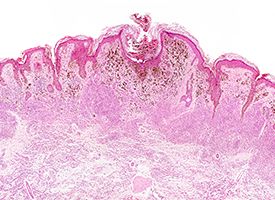Ipilimumab Effective in Adolescents With Advanced Melanoma
Ipilimumab was associated with a 1-year overall survival rate of 75% in adolescent patients with stage III/IV unresectable malignant melanoma.

Ipilimumab (Yervoy) was associated with a 1-year overall survival (OS) rate of 75% in adolescent patients with stage III/IV unresectable malignant melanoma.
Ipilimumab is approved for adult patients, but there is little data regarding the safety and efficacy of the anti-CTLA-4 monoclonal antibody in children or adolescents. To investigate, researchers in the United States and Europe conducted Study CA184-178, a single-arm, multicenter, open-label phase II study of ipilimumab in patients aged 12 to <18 years (N = 12) with previously treated or untreated, unresectable stage III/IV advanced melanoma.
Patients with ocular melanoma, active brain metastases, history of autoimmune disease, or prior therapy with CTLA-4, PD-1, PD-L1, or CD137 targeted agents were excluded.
The study designed called for 40 patients to enroll at 32 sites across 10 countries, and 80% of the sites were activated by December 2013. As of April 2016, only 14 patients had enrolled and just 12 had been treated at 10 centers. Four patients received 3 mg/kg of ipilimumab and 8 patients were treated with 10 mg/kg of ipilimumab every 3 weeks for 4 courses. No additional patients were enrolled after April 2015, and all treated patients completed 1-year survival follow-up.
Patients were initially assigned to 10 mg/kg of ipilimumab, but the dose was amended to 3 mg/kg based on the approved adult ipilimumab dose for this indication in 2014.
Median OS was 18.2 months (95% CI, 8.9-18.2) in the 3 mg/kg cohort and not reached (95% CI, 5.2-not reached) in the 10 mg/kg cohort. The Kaplan-Meier estimated 1-year OS rate was 75.0% (95% CI, 12.8-96.1) in the 3 mg/kg ipilimumab cohort and 62.5% (95% CI, 22.9-86.1) in the 10 mg/kg cohort. Three of 4 patients in the 3 mg/kg arm and 5 of 8 patients in the 10 mg/ kg arm were alive at 1 year. However, 9 of 12 experienced disease progression in that time.
First author Birgit Geoerger, MD, PhD, head of the Paediatric Early Drug Development Programme at Institut Gustave Roussy in Villejuif, France, and co-investigators noted that median OS was superior in this population compared with adults (10.1 months).
“Although the number of patients was limited due to enrollment challenges and the rarity of this disease in younger patients, survival rates were comparable to those seen in the adult population, where the 1-year overall survival rate was 45.6%,” Geoerger et al wrote. “Disease control rate of approximately 25% was similar to the 28.5% reported in the adult population using a 3 mg/kg dosing schedule.
“The experience in this study warrants the consideration of including children and adolescents in adult trials of promising new drugs or their combinations to adequately explore beneficial treatment options for this fragile study population with such diseases as advanced melanoma.”
Two patients (28.6%) in the 10 mg/kg cohort had partial response, 1 lasting more than 3 years. Four patients (57.1%) in that group had progressive disease and 1 was not evaluable. The objective response rate and disease control rate were both 28.6%. The best response in the 3 mg/kg arm was stable disease (n = 1; 25.0%). Three patients had progressive disease.
Median progression-free survival was 2.6 months (95% CI, 2.3-8.5) in the 3 mg/kg cohort and 2.9 months (95% CI, 0.7-not reached) in the 10 mg/kg cohort.
Two patients (50%) in the 3 mg/kg cohort and 7 (88%) in the 10 mg/kg cohort experienced at least 1 treatment-related adverse event (TRAE). One patients in the 3 mg/kg cohort and 5 in the 10 mg/kg required treatment discontinuation due to TRAEs.
One-quarter of 3 mg/kg patients and 62.5% of those in the 10 mg/kg cohort experienced grade 3/4 TRAEs. Researchers said the safety profile was similar to that observed in adult patients.
One patient in the 3 mg/kg cohort and 5 in the 10 mg/kg grout reported experiencing grade 3/4 immune-mediated adverse reactions. There were no treatment-related deaths recorded. However, half of the patients in the 3 mg/kg cohort and 3 (38%) in the 10 mg/kg cohort died from disease progression at the time of study closure.
Geoerger B, Bergeron C, Gore L, et al. Phase II study of ipilimumab in adolescents with unresectable stage III or IV malignant melanoma. Eur J Cancer. 2017;86:358-363. doi:10.1016/j.ejca.2017.09.032.



